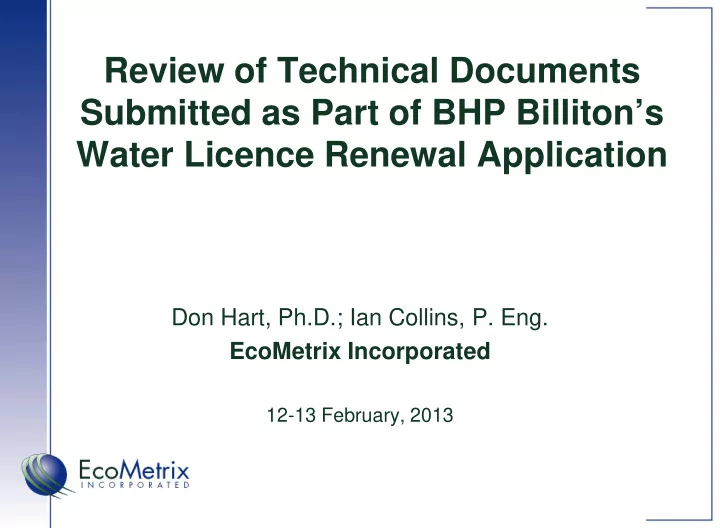

Review of Technical Documents Submitted as Part of BHP Billiton’s Water Licence Renewal Application Don Hart, Ph.D.; Ian Collins, P. Eng. EcoMetrix Incorporated 12-13 February, 2013
Scope • Water quality modeling – methods, assumptions, uncertainties, predictions vs monitoring data • Derivation of site-specific water quality objectives (SSWQOs) – methods, assumptions, uncertainties • Parameters of Interest deemed not of potential concern (predicted < 75% of SSWQO) (Mo, SO 4 , V) • Parameters of Potential Concern (predicted > 75% of SSWQO) but no EQC (K, Cl) • Parameters of Potential Concern (predicted > 75% of WQO) but no EQC (Al, Cd, Cu, Se)
Water Quality Model (Rescan) Watershed Watershed Watershed Cell 1616 - 30 A DIKE E DIKE D DIKE C DIKE B Cell E Cell D Cell C Cell B Leslie Lake Reclaim Water Beartooth Underground Water Process Plant Koala Panda Watershed Natural Runoff Waste Water Site Runoff Pumped Flows Seepage Processed Kimberlite
Water Quality Model • Load Balance Model – Cells A-E, Beartooth Pit submodel – geochemical predictions for pit wall input • Downstream Model – Leslie, Moose, Nema, Slipper • Modeled as a series of well-mixed stirred tanks • Cell D modelled with two layers • Nutrient degradation in Load Balance Model only • Water balance calibrated to measured flows • Flows from underground workings assumed constant • Planned future flows out of Beartooth Pit • Water quality based on measured concentrations for PPD, natural runoff, sump water, underground water
Review of Water Modeling • Modeling methods and assumptions are reasonable, uncertainties not large enough to alter conclusions. • Predictions agree well with measured lake water quality, usually either accurate or conservative • Ammonia, barium slightly under-predicted in the Koala watershed lakes • Iron under-predicted in Nema and Slipper lakes, but will not approach WQO • These small under-predictions are unlikely to alter conclusions about chemicals of potential concern
Derivation of SSWQOs • Based on Species Sensitivity Distributions (SSD) • Followed CCME (2007) methods (5 th percentile, HC 5 ) • Used “resident” species, and “surrogate” species • Used “acceptable” studies based on quality review • Chronic “no-effect” concentration for each species • SSWQO is HC 5 , or hardness adjusted HC 5 • Hardness adjustment for SO 4 , Cl, nitrate-N • No hardness relationship for K, Mo, V • Overall, the SSWQO methodology is appropriate • Assumption- species used represent the community
Example- SSD for Mo (Rescan) 1.0 Lemna minor Normal Model 95% Confidence Limits Fish Invertebrate Lymnaea stagnalis Alga/Plant 0.8 y = ½ { 1 + erf [ (0.383 2) ]} (x-1.917) Brachionus calyciflorus Chironomus riparius 0.6 Daphnia magna Pimephales promelas Proportion of Taxa Affected 0.4 Ceriodaphnia dubia Chlorella regularis 0.2 HC 5 = 19 mg/L Oncorhynchus mykiss Pseudokirchneriella subcapitata 0.0 1 10 100 1,000 10 , 000 Total Molybdenum (mg/L)
Key Uncertainties in SSWQOs • Chloride – SSWQO adopted from Elphick (2011) - Hardness relationship for C.dubia assumed for other sensitive species (all daphnids in Elphick’s SSD) - Clams may be more sensitive? they drive the lower HC 5 of 120 mg/L from CCME (2011) • Nitrate – SSWQO is an HC 5 , hardness adjusted - Hardness relationship, a pooled slope from 4 taxa, assumed representative for other sensitive species (lake trout?). New data - trout is hardness protected. • Sulphate – SSWQO is an HC 5 , hardness adjusted - Hardness relationship for C. dubia assumed for other sensitive species (trout?). New data - trout protected
Parameters of Interest Deemed not of Potential Concern • Sulphate - SSWQO is 566 mg/L at hardness 160 - max predicted 133 mg/L Leslie, 137 mg/L Moose - only 24% of SSWQO (not 75%) • Molybdenum - SSWQO is 19 mg/L - max predicted 0.168 mg/L Moose Lake - < 1% of SSWQO (not 75%) • Vanadium - SSWQO is 0.03 mg/L - max predicted 0.0062 mg/L Leslie Lake - only 21% of SSWQO (not 75%)
Parameters of Potential Concern (Predicted > 75% of SSWQO) but no EQC due to “low risk” • Chloride - SSWQO is 388 mg/L at hardness 160 - max predicted 392 mg/L Moose, 383 mg/L Leslie - 101% and 99% of SSWQO • Potassium - SSWQO is 41 mg/L - max predicted is 42 mg/L Moose, 41 mg/L Leslie - 103% and 100% of SSWQO Opinion – predicted to reach SSWQO implies a low level of effect on a few sensitive species; EQC links to SSWQO but allows closer scrutiny than annual AEMP; an EQC would be reasonable .
Parameters of Potential Concern (Predicted > 75% of WQO) but no EQC due to “low risk” • Aluminum - WQO is 0.1 mg/L for pH >6.5 (CCREM) - max predicted 0.15 mg/L Leslie Lake - Chapman memo suggests low or negligible risk at this level, due to particulate form or DOC or hardness, particularly in the pH 6-8 range - Rescan memo indicates 87% dissolved in Leslie - Further work needed to show no effects at 0.15mg/L • Cadmium - WQO is too low, under revision. - max predicted 0.3 ug/L in Leslie, hardness 350 - meets EPA WQC. Wait for CCME revision.
Parameters of Potential Concern (Predicted > 75% of WQO) but no EQC due to “low risk” • Copper - WQO is as low as 2 ug/L at low hardness (CCREM) but Cu is mainly due to natural runoff - max predicted 2.5 ug/L Nema, but below WQO - predicted 2 ug/L Slipper, equal WQO (low hardness) - No benefit of EQC since mine does not control Cu • Selenium - WQO is 1 ug/L, but tissue better indicator - max predicted 1.2 ug/L in Leslie, RW flesh now 4.4 mg/kg dw (BHPB response to IEMA, Jan 2013, p12) - EPA draft 7.9 mg/kg dw , BC MOE 1 mg/kg ww - an EQC permits close scrutiny of effluent, not tissue
Thank you. • Questions?
Recommend
More recommend